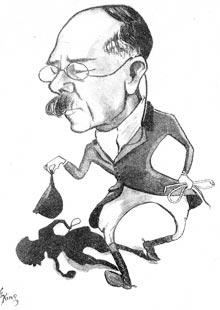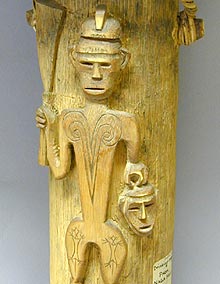'The Happiest Years': J H Hutton and the Nagas

Caricature of Hutton in hunting-kit from Illustrated Weekly of India
(Detail and enhancement of 1998.271 collection, copyright PRM)
John Henry Hutton (1885-1968) was born in Yorkshire, educated at Oxford, joined the Indian Civil Service in 1909, and spent most of his administrative career in the Indian-Burmese border region, particularly in the Naga Hills. In 1937 he was appointed to the prestigious William Wyse chair of Social Anthropology at Cambridge, from which he retired in 1950.
Hutton spent much of his time as magistrate and Deputy Commissioner, visiting almost all the Naga groups in India, and becoming (in the words of Henry Balfour, the first Curator of the Pitt Rivers): 'The greatest authority on the Naga Hills in general'. Hutton himself explained how his career fed his anthropological work: 'The account of the Semas given in this book* has been compiled at Mokochung and Kohima in the Naga Hills during an eight years' acquaintance with them, during which I have learnt to speak the language fairly fluently and have been brought into contact with the life of the individual, the family and the community ... there is hardly any point of tribal custom which is not sooner or later somehow drawn into one of the innumerable disputes which the local officer in the Naga Hills is called upon to settle ...'
His time in the Naga Hills not only provided him with material for two seminal ethnographic publications, but also led to one of the largest, most colourful collections of artefacts in the Museum. Hutton became a close friend of Balfour, and gave a total of 3564 objects, of which 2783 came from the Naga Hills, to the Pitt Rivers. The collection includes weapons, bowls, figures, textiles, clothing and ornaments, and it is complimented by an equally comprehensive Naga collection from his colleague and friend James Philip Mills.

Bamboo Drinking Vessel from Phom, Naga Hills donated by Hutton
(Detail and enhancement of 1923.85.575, copyright PRM)
Mills gave an account of one of the tours he made with Hutton: 'In a village which ... Hutton and I were the first to visit we noticed in a house a great padded helmet and a heavy single-stick with a guard ready to hand by the owner's bed. We were told that they were for use in inter-clan fights which were apt to flare up very suddenly and had to be settled without use of weapons likely to cause bloodshed ... what a wonderful starting point is this information, which we should probably have never got by a direct question on clan relationships ...The information is with the helmet and single-stick in the Pitt Rivers Museum , where many other labels of this type provide valuable clues for social anthropologists ...*'
In 1967 Hutton wrote that he hoped that his book The Angami Nagas *contributed 'to the knowledge of a people in whose delightful company I passed what were probably the happiest years I had known since I left childhood ...'
* Hutton's The Sema Nagas was published in 1921 by Macmillan; and The Angami Nagas, also published by Macmillan in the same year, was reprinted in 1969. Mills' account appears in his article Anthropology as Hobby in the Journal of the Royal Institute of Anthropology, Vol 3 No. 1 (Jan - June 1952). The helmet and single-stick referred to by Mills are probably under accession numbers 1934.82.98 and 99.
Alison Petch, Registrar, Pitt Rivers Museum

